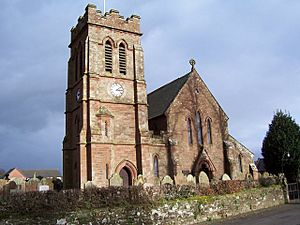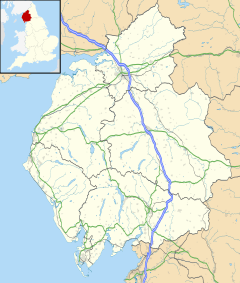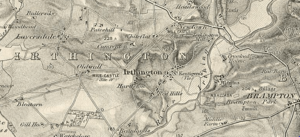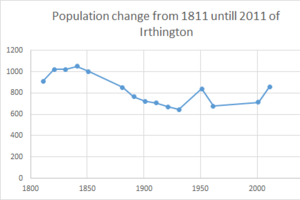Irthington facts for kids
Quick facts for kids Irthington |
|
|---|---|
 St Kentigern's Church |
|
| Population | 860 (Census 2011) |
| OS grid reference | NY4918059994 |
| Civil parish |
|
| District |
|
| Shire county | |
| Region | |
| Country | England |
| Sovereign state | United Kingdom |
| Post town | Carlisle |
| Postcode district | CA6 |
| Dialling code | 01697 |
| Police | Cumbria |
| Fire | Cumbria |
| Ambulance | North West |
| EU Parliament | North West England |
| UK Parliament |
|
Irthington is a small village in Cumbria, England. It's part of the City of Carlisle district. You can find it northeast of the Carlisle Lake District Airport. In 2011, about 860 people lived here.
Contents
What's in a Name?
The name Irthington comes from an old language called Old English. It means 'farm or village by the river Irthing'.
A Look Back in Time
The most exciting time in Irthington's past was during the Roman era. Irthington sits right on top of the old Roman road called Stanegate. This road was built even before Hadrian's Wall. It stretched from Corbridge in the east to Carlisle in the west.
In 1884, people described the village as being "cut through by the great Roman wall." It was also crossed by the military road that went from Newcastle to Carlisle.
St Kentigern's Church
Some of the stones used to build the south wall of St Kentigern's church might have come from Hadrian's Wall. The wall was less than 1 kilometer (about half a mile) northwest of the village. However, many of its stones were taken by people for other buildings.
St Kentigern's church itself dates back to Norman times. It was repaired in 1849 in a Gothic style. More work has been done since then, including adding a clock tower with five bells. Inside the church, you can still see old round arches from the 1170s.
Irthington Castle
The remains of Irthington Castle are also nearby. This was a medieval castle built on a mound of earth, called a motte. It's just a short walk south of the church.
In the 1870s, Irthington was described as a village, a township, and a parish. It covered about 947 acres (383 hectares).
How Many People Live Here?
In the 2011 census, 860 people lived in Irthington. Back in 1831, there were 1049 residents. The number of people has changed a bit over the last 200 years. There was a big jump in 1951. This happened because the village's boundary changed, including more people.
The number of men and women has usually been quite similar. In 1801, there were 430 men and 440 women. In 2011, there were 416 men and 444 women. This is only a small difference. Most people living in Irthington were born in the UK. In 2011, 98% of residents were born in the UK. Newtown is another village located within Irthington.
What Jobs Do People Do?
In 1881, a lot of people in Irthington worked in farming. About 197 people, or 23% of the 853 residents, worked in agriculture. This was the biggest job area in the village. The next largest group was people without a specific job, making up 12% of the population. The third most common job was "domestic services and offices," with 57 people (7%). These top three jobs made up 42% of all jobs in the village.
Today, the jobs in Irthington have changed a lot.
- The most common job is in skilled trades, with 118 people (14%). This is higher than the national average.
- Next are professional jobs, with 80 people (9%). This is about half the national average.
- Third are managers, directors, and senior officials, making up 6% of jobs. This is also below the national average.
The village no longer relies so much on farming. The top three jobs now make up 29% of all jobs, which is 11% less than in 1881.
Visiting Irthington
Irthington has several places to stay if you're visiting. There are eight hotels or inns in the area. The nearby Carlisle Lake District Airport could be useful for tourists once it offers passenger flights.
A big reason people visit Irthington is its close location to the Hadrian's Wall trail. Many people walking the trail stop in the village. However, tourism isn't a huge part of the local economy.
Getting Around
Irthington is a bit out of the way. The closest train station is Carlisle railway station, which is about 9 miles (14.5 kilometers) away. It takes about 20 minutes to get there by car.
The nearest airport is Carlisle Lake District Airport, just over 1 mile (1.6 kilometers) from Irthington. The airport wasn't offering regular passenger flights for a while. However, work started in 2014 to bring flights to places like London and Dublin by 2016. This development was also expected to create 800 jobs.
Images for kids






